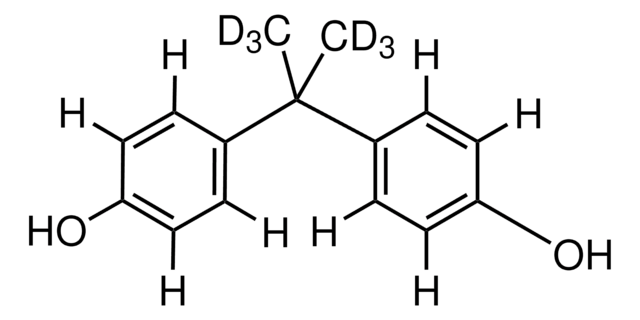239658
Bisphenol A
≥99%
Synonym(s):
2,2-Bis(4-hydroxyphenyl)propane, 4,4′-Isopropylidenediphenol
About This Item
Recommended Products
Assay
≥99%
form
solid
bp
220 °C/4 mmHg (lit.)
mp
158-159 °C (lit.)
SMILES string
CC(C)(c1ccc(O)cc1)c2ccc(O)cc2
InChI
1S/C15H16O2/c1-15(2,11-3-7-13(16)8-4-11)12-5-9-14(17)10-6-12/h3-10,16-17H,1-2H3
InChI key
IISBACLAFKSPIT-UHFFFAOYSA-N
Gene Information
mouse ... Esr1(13982)
rat ... Ar(24208)
Looking for similar products? Visit Product Comparison Guide
Related Categories
General description
Application
- Quantitative analysis of bisphenol A and bisphenol S in three plastic product samples of a mineral water bottle, polycarbonate bottle, and baby bottle, using a modified glassy carbon electrode (GCE) sensor based on a crystalline covalent organic framework (COF)
- Simultaneous determination of bisphenol A, S, and F in 112 samples of thermal paper receipts by liquid chromatography coupled to mass spectrometry (LC-MS) following their ultrasound-assisted extraction
- Development and validation of a gas chromatography-tandem mass spectrometry (GC-MS/MS) method for the measurement of bisphenol A and 18 BPA-related compounds in 30 breast milk samples after their solid phase extraction (SPE)
- Construction of an electrochemical sensor based on multi-walled carbon nanotubes (MWCNTs) modified glassy carbon electrode (GCE) for the determination of bisphenol A & S in river water and thermal paper samples by cyclic voltammetry (CV)
- Determination of bisphenol A in urine samples using a novel method based on miniaturized QuEChERS extraction and gas chromatography-mass spectrometry (GC-MS)
- Investigate the bisphenol A content from glass or Pasteur pipettes in biological liquids from maternal women using high-performance liquid chromatography (HPLC).
Signal Word
Danger
Hazard Statements
Precautionary Statements
Hazard Classifications
Aquatic Acute 1 - Aquatic Chronic 1 - Eye Dam. 1 - Repr. 1B - Skin Sens. 1 - STOT SE 3
Target Organs
Respiratory system
Storage Class Code
6.1C - Combustible acute toxic Cat.3 / toxic compounds or compounds which causing chronic effects
WGK
WGK 3
Flash Point(F)
440.6 °F - closed cup
Flash Point(C)
227 °C - closed cup
Personal Protective Equipment
Certificates of Analysis (COA)
Search for Certificates of Analysis (COA) by entering the products Lot/Batch Number. Lot and Batch Numbers can be found on a product’s label following the words ‘Lot’ or ‘Batch’.
Already Own This Product?
Find documentation for the products that you have recently purchased in the Document Library.
Customers Also Viewed
Protocols
A comprehensive sample preparation and analytical procedure was developed by Supelco for determining BPA in drinking water.
Our team of scientists has experience in all areas of research including Life Science, Material Science, Chemical Synthesis, Chromatography, Analytical and many others.
Contact Technical Service












